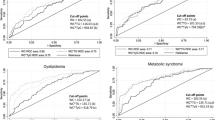Abstract
Since its conception, the metabolic syndrome has received worldwide recognition as a useful clinical aid for predicting cardiovascular risk. The earliest definition, which included risk factors such as insulin resistance, hyperglycemia, hypertension, and cholesterol, has undergone many transformations. Two revisions have focused on visceral adiposity as an essential component of the syndrome, particularly in Asian populations. The Japanese national guidelines have also suggested that abnormalities in adipose tissue metabolism are an underlying molecular cause of the syndrome. In addition, emerging evidence suggests that lowering the threshold of waist circumference in Asian populations increases the prevalence of the metabolic syndrome. Inevitably, this widening of the threshold will capture more patients at risk of cardiovascular events. The aim of this Article is to consider the country-specific impact of the metabolic syndrome, using the evolution of the definition in Japan as a model.
Key Points
-
The metabolic syndrome has been acknowledged in Japan as a major public-health concern and is being addressed at a national level by the development of country-specific guidelines
-
As well as the traditional risk factors of dyslipidemia, raised blood pressure, and raised fasting plasma glucose, the Japanese guidelines also include waist circumference
-
Although adiposity was included in early definitions of the metabolic syndrome, the syndrome's prevalence remained low in Asian populations until obesity cut-off values were altered according to ethnicity
-
The inclusion of visceral adiposity suggests that abnormalities in adipose tissue present a potential molecular basis for the metabolic syndrome
This is a preview of subscription content, access via your institution
Access options
Subscribe to this journal
Receive 12 print issues and online access
$209.00 per year
only $17.42 per issue
Buy this article
- Purchase on Springer Link
- Instant access to full article PDF
Prices may be subject to local taxes which are calculated during checkout

Similar content being viewed by others
References
Reaven GM (1988) Banting lecture 1988. Role of insulin resistance in human disease. Diabetes 37: 1595–1607
Alberti KG et al. (2005) The metabolic syndrome—a new worldwide definition. Lancet 366: 1059–1062
Alberti KG et al. (2006) Metabolic syndrome — a new world-wide definition. A Consensus Statement from the International Diabetes Federation. Diabet Med 23: 469–480
Grundy SM et al. (2005) Diagnosis and management of the metabolic syndrome: an American Heart Association/National Heart, Lung, and Blood Institute Scientific Statement. Circulation 112: 2735–2752
Matsuzawa Y (2005) Metabolic syndrome—definition and diagnostic criteria in Japan. J Jpn Soc Int Med 94: 188–203
World Health Organization (1999) Definition, diagnosis and classification of diabetes mellitus and its complications. Report of a WHO consultation. Part 1: Diagnosis and classification of diabetes mellitus. Geneva, World Health Organization
Expert Panel on Detection, Evaluation, and Treatment of High Blood Cholesterol in Adults (2001) Executive Summary of The Third Report of The National Cholesterol Education Program (NCEP) Expert Panel on Detection, Evaluation, and Treatment of High Blood Cholesterol in Adults (Adult Treatment Panel III). JAMA 285: 2486–2497
WHO Expert Consultation (2004) Appropriate body-mass index for Asian populations and its implications for policy and intervention strategies. Lancet 363: 157–163
Matsuzawa Y (2005) Metabolic syndrome—definition and diagnostic criteria in Japan. J Atheroscler Thromb 12: 301
Oda E and Watanabe K (2006) Japanese criteria of metabolic syndrome. Circ J 70: 364
Tan CE et al. (2004) Can we apply the National Cholesterol Education Program Adult Treatment Panel definition of the metabolic syndrome to Asians? Diabetes Care 27: 1182–1186
Takeuchi H et al. (2005) Metabolic syndrome and cardiac disease in Japanese men: applicability of the concept of metabolic syndrome defined by the National Cholesterol Education Program—Adult Treatment Panel III to Japanese men—the Tanno and Sobetsu Study. Hypertens Res 28: 203–208
Sone H et al. (2005) Is the diagnosis of metabolic syndrome useful for predicting cardiovascular disease in asian diabetic patients? Analysis from the Japan Diabetes Complications Study. Diabetes Care 28: 1463–1471
Sone H et al. (2006) The new worldwide definition of metabolic syndrome is not a better diagnostic predictor of cardiovascular disease in Japanese diabetic patients than the existing definitions: additional analysis from the Japan Diabetes Complications Study. Diabetes Care 29: 145–147
Miyatake N et al. (2006) Prevalence of metabolic syndrome in Okayama prefecture, Japan. Intern Med 45: 107–10855
Acknowledgements
PAREXEL MMS provided writing assistance, comprising preparation of a draft from slides and audio transcript, preparation of figures and obtaining copyright permissions, proofreading, and reference checking.
Author information
Authors and Affiliations
Ethics declarations
Competing interests
The author declares no competing financial interests.
Rights and permissions
About this article
Cite this article
Fujita, T. The metabolic syndrome in Japan. Nat Rev Cardiol 5 (Suppl 1), S15–S18 (2008). https://doi.org/10.1038/ncpcardio0808
Received:
Accepted:
Issue Date:
DOI: https://doi.org/10.1038/ncpcardio0808
This article is cited by
-
Metabolic syndrome and masticatory hypofunction: a cross-sectional study
Odontology (2021)
-
Changes in metabolic profiles after the Great East Japan Earthquake: a retrospective observational study
BMC Public Health (2013)
-
Objectively measured light-intensity lifestyle activity and sedentary time are independently associated with metabolic syndrome: a cross-sectional study of Japanese adults
International Journal of Behavioral Nutrition and Physical Activity (2013)
-
Childhood obesity: a life-long health risk
Acta Pharmacologica Sinica (2012)
-
Association between physical activity and metabolic syndrome in middle-aged Japanese: a cross-sectional study
BMC Public Health (2011)



